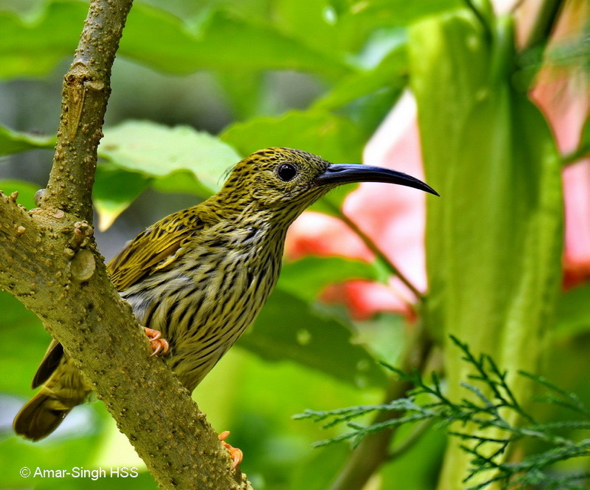“Wells (2007) states that ‘For a species so regularly using hill-station garden habitat, flower-visiting behaviour is seriously under reported‘. I have seen Streaked Spiderhunters (Arachnothera magna musarum) feed on a wide range of nectar sources, occasionally using nectar robbing techniques.
“Previous nectar sources seen/documented include:
1. Poikilospermum suaveolens (Family: Urticaceae) – seen feeding on the flowers (they eat the flowers to get to the nectar).
2. Malvaviscus arboreus – resembles a partially closed hibiscus flower; nectar robbing seen.
3. Sanchezia nobilis – conventional nectar feeding.
4. Sanchezia speciose – conventional nectar feeding.
5. Canna species (an orange-red cultivar) – conventional nectar feeding.
6. Musa coccinea, commonly known as Scarlet Banana or Red-Flowering Banana – conventional nectar feeding.
7. Bottlebrushes (Callistemon spp.) – conventional nectar feeding.
“On this occasion I the saw the adults of the family unit I reported yesterday feeding on two other nectar sources.
1. “Pink flowering Brugmansia suaveolens (Angels Trumpets) or one of its hybrids (above). This group of plants is not indigenous to our region but are native to Brazil. The long tubular, trumpet shaped flowers result in the Streaked Spiderhunters use nectar robbing i.e. inserting the bill into the upper side of the flower to extract nectar with no pollen exchange (below). Note that even older/drying flowers are used.
“In their native environment most Brugmansia are pollinated by moths with long proboscis, attracting them by night time fragrance. One species is pollinated by the Long-billed Hummingbird. Brugmansia are poisonous plants due to the presence of tropane alkaloids (scopolamine, hyoscyamine, atropine, etc.) in every part of the plant. It was used by many South American indigenous tribes in therapy and ceremonies to subdue women before they were buried alive with the dead or difficult to manage children – the hallucinations and disorientation aid the compliance but may lead to death due to varying/uncertain concentrations of alkaloids.
2. “Hibiscus rosa-sinensis (double pink flowers) – above shows an adult Streaked Spiderhunter nectar feeding on the flower.
“A close up of the adults is shown above.”
Dato’ Dr Amar-Singh HSS
Ipoh, Perak, Malaysia
7th July 2018
Location: 1,700m ASL, Cameron Highlands, Pahang, Malaysia
Habitat: Trail through primary jungle
Reference:
Wells, D.R., 2007. The birds of the Thai-Malay Peninsular. Vol. II, Passerines. Christopher Helm, London. 800 pp.












